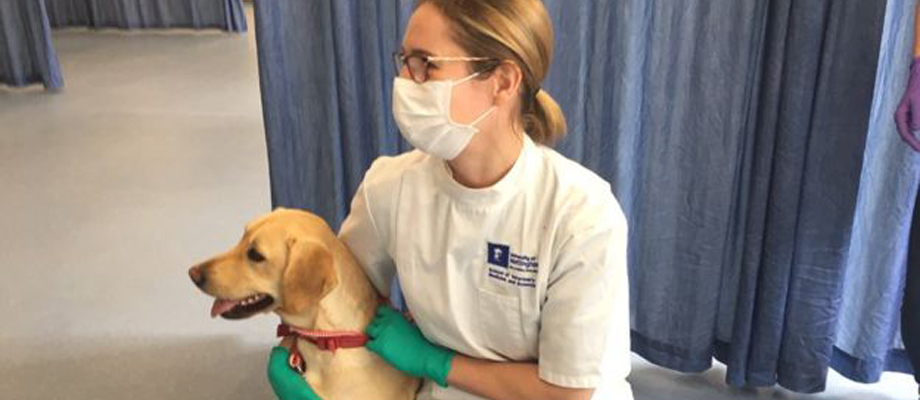
Deputy Vice-Chancellor’s blog: Re-opening the Vet School – a personal perspective
August 4th, 2020
This week, Clinical Assistant Professor in Clinical and Professional Skills Dr Sarah Cripps writes about her experiences in preparing the Vet School for reopening and welcoming students back for in-person teaching last week.
Last week was a special week at the Vet School, as we welcomed our April cohort of first year students to campus and began their in-person teaching. We know this cohort through remote learning since they ‘arrived’ for Freshers at the end of March, with hours spent on Teams teaching them the mysteries of Animal Health and Welfare and the Neurological and Muscular systems.
The main activity on the first day was an orientation tour of the Vet School teaching areas. The COVID restrictions have meant that the already convoluted corridor systems and the confusing names to the various rooms are even more likely to result in lost students, as there are now strict one-way routes in place. Clear signage helps, with regular reminders to wear face coverings, stay in household groups, apply hand-sanitiser, place used protective clothing in specified areas, and avoid two-way traffic in the corridors by following the specified routes.
I was pleased to be able to conduct the tours, as I am now familiar with the new routes and where to direct students to for their teaching. This also meant I was able to meet some of the students. I have missed our students and the practical teaching and so as we wandered through the various circular routes in and out of the Vet School and animal handling facilities, we were able to chat about how remote learning has worked for them, what they thought of their flats, and how much they were looking forward to practical sessions.
Three days later, I donned my mask, gloves, lab coat and visor and shut myself in the rodent room, to teach small household groups of approximately five students animal handling sessions with our very lively rats, mice, and gerbils. They also handle rabbits and guinea pigs, and bearded dragons and snakes with my colleagues in these sessions; other stations over the five-week course are with horses, dogs, and farm animals. By completion, every student will have handled every species and hopefully be competent and confident for future opportunities. It was a hot little room and an intensive teaching session, but it was very enjoyable. The students had done all the pre-reading and were calm and confident handling the animals. They had had a dissection session earlier in the week and I asked how it had gone. Every student I spoke to was overwhelmingly positive, many said ‘it all makes sense now I have seen it in three dimensions’ and ‘it was so good to finally be able to draw our learning together by working with a real specimen’.
The need to bring our April cohort back earlier than most courses meant we were always going to have to be very proactive in finding a safe way in which to do so. Additionally, the nature of the veterinary course and the style of delivery at Nottingham Vet School poses problems due to the close working environment in the numerous practical sessions. As the momentum to return our first years gathered, we created a series of timetables and potential ways of safe delivery; many early iterations were abandoned as guidance changed. This was frustrating, especially as at the same time ongoing work was needed to rewrite teaching material for remote delivery. University level meetings gradually morphed into School level meetings then teaching group meetings as the guidance was finalised and approved, and the logistical details were determined for every taught session. Patience and effective team working have been essential and all the staff here have risen to the challenge.
When we work together in person, conversations are natural and spontaneous, around the kettle in the staff room, or in the corridor walking to and from meetings. We know how our colleagues are feeling and can act to help if they seem overloaded. The move to scheduled timed online meetings has taken these unplanned interactions away and checking in personally on one’s close work colleagues has never been more important. If someone reacts differently in an email, or seems less helpful than usual, it may just be that they are struggling to find a way through the confusing working situation. Good relationships with work colleagues have been invaluable; I intend to continue trying to find ways to nurture them remotely, to have virtual coffees where we don’t discuss work, and ask how their kids, pets, or partners are.
This new week is intense for the first years. I am looking forward to a busy yet rewarding and exciting week as I play my own part in teaching live dog clinical examination and ultrasound practicals to the whole year, in small groups of socially distanced students. I am so pleased that I can do this safely on campus, in-person, with the teaching animals and proper equipment – and so thankful to all the University colleagues who have made this possible.
Tags: blog, deputy vice chancellor, Dr Sarah Cripps, recovery, recovery blog, Recovery Group, Vet School
Comments are closed.
Other

Need news? See you on SharePoint
After 14 years of service, Campus News is being retired as the university’s staff news platform. […]

Roads and car parks closed for refurbishing work
As part of ongoing road improvements at the university, works will be taking place to resurface […]

